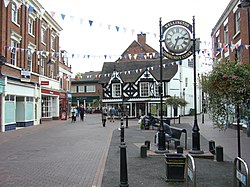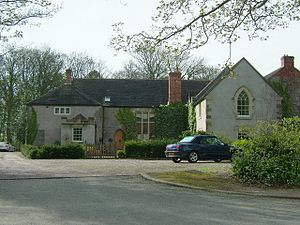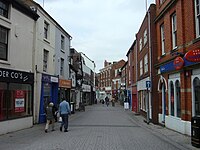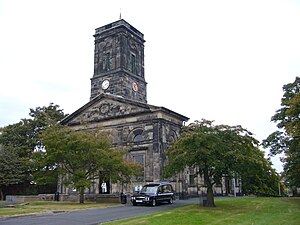Wellington, Shropshire
| Wellington | |
| Shropshire | |
|---|---|
 Centre of Wellington | |
| Location | |
| Grid reference: | SJ651115 |
| Location: | 52°42’0"N, 2°30’57"W |
| Data | |
| Population: | 24,200 |
| Post town: | Telford |
| Postcode: | TF1 |
| Dialling code: | 01952 |
| Local Government | |
| Council: | Telford and Wrekin |
| Parliamentary constituency: |
The Wrekin |
Wellington is a town in Shropshire which now forms part of the new town of Telford. The population of the civil parish of Wellington was recorded as 20,430, making it the third-largest town in Shropshire if counted independently from Telford.
Contents
History
A church has stood at the heart of the town for almost 1000 years as a priest is mentioned in the Domesday Book. The original churchyard still remains. A new church, designed by George Steuart, was built in 1789.[1]
Wellington's first market charter was granted to Giles of Erdington, lord of the manor, and is dated 1244 and a market still exists today. The market had an open-sided market hall by 1680 but this was dismantled c.1805. This was replaced in the 19th century by a town hall (with the butter market held under it) built in 1848 by a company (formed in 1841) which purchased the market rights from Lord Forester in 1856.[2]
In 1642, King Charles I stayed overnight 'in the environs of Wellington when on his way from Newport to Shrewsbury to rally support for his cause and while here he made his 'Wellington Declaration' in which he said that he would uphold the Protestant Religion, the Laws of England, and the Liberty of Parliament.
The second Shropshire Olympian Games were held in Wellington in May 1861.
To the north-east of the town is the site of Apley Castle, originally a fourteenth-century fortified manor house, the remains of which were converted into a stable block with the building of a grand Georgian house, which was itself demolished in the 1950s. The surviving stable block has been converted into apartments and retains some mediæval features.[3]
The creation of Telford
A new town named 'Dawley New Town' was designated in 1963. It was expanded to include Wellington in 1968 and the development was renamed 'Telford New Town'; this has divided opinion in Wellington ever since, with some celebrating the jobs and investment it brought to the area and others bemoaning the negative impact on Wellington's own economy - as well as its sense of history and identity.[4] The development of Telford Town Centre since the 1970s hit Wellington's traditional shops hard, and the renaming of the local football team from Wellington Town to Telford United highlighted to many the risk that Wellington was being erased as a town in its own right.
Local politics left Wellington in conflict with Wrekin District (now Telford & Wrekin) Council for many years, with claims and counter claims of neglect. In more recent years, however, the Council has started making heavy investment to make improvements to the town. Critics feel this it is not about new Bus Stations and Libraries but a need for more commercial and viable shopping stunted mainly by high rents and rising Business Rate Bills, enforced by central government and not benefitting the local community.
The creation of the new town did, however, bring employment to the area.[4] Although ignored by most of the larger high street stores, some independent businesses have remained in Wellington. In a story common to so many small towns, the economic downturn has compounded the challenges already created by out of town shopping, with empty premises and ongoing concerns about 'too many charity shops'
Wellington continues to try and find its place in the local economy but losing large national stores to Telford Centre only makes the challenge harder.
Amenities and attractions
Local magazine the Wrekin News is published monthly. Artistic events in Wellington include Sounds in the Square, a season of open air music in the Market Square during the Summer, and the well-attended annual Wellington Literary Festival, a celebrated month of workshops, competitions and even audiences with famous poets and authors. The annual Midsummer Fayre and Lions day on wheels are two other popular events held during the summer months.
Wellington Market continues to be a popular attraction of the town, and is open on Tuesday, Thursday, Friday and Saturday. There is also a monthly farmers' market held in the Square. The town centre is the largest shopping centre in Telford outside the new, central Telford Shopping Centre.
The New Buck's Head football stadium, home to AFC Telford United, is located in Wellington. Other sporting clubs include the Wellington Cricket Club, currently in the Birmingham League Premier Division. The Wrekin, a hill on the border of Wellington, has a height of 1335 feet and is popular with walkers and families. It plays host to the annual Great Wrekin Barrel Race.
Wellington is also home to the Belfrey Theatre an amateur venue run by the Wellington Theatre Company which puts on an annual season of plays and other shows.
The Wetherspoon chain of real ale eateries has opened a new pub in New Street, Wellington, The William Withering, named for Dr William Withering who was born in the town and who discovered Digitalis, the heart medicine. With its impressive array of pictures and captions festooned around the pub's walls, it's become something of a popular historical attraction for patrons of all ages.
Wellington also has Walkers are Welcome Status and recently an Outdoor Walking shop opened to cater for the many walkers named Wrekin Rambler, which offers discount to walkers and uniformed services.
Transport links
Wellington railway station was built in 1849 and has three platforms providing northbound trains towards Shrewsbury and Wales, and southbound trains to the Black Country and Birmingham. One of the platforms is a bay platform, which sees little use at present. Additionally, from 2008 - 2011 the town had a through train service to London Marylebone, the first for almost 40 years.
In 1867, a branch line was opened to connect the town with Market Drayton. The Wellington and Market Drayton Railway operated for just under one hundred years before closure under the Beeching Axe in 1963. The line remained open for goods only services until 1967, when this service was also withdrawn. The track was lifted in the early 1970s.
There were also railway links to Much Wenlock and Stafford, both closed in the late 1960s.
A goods only link to a rail head at Donnington, on part of the former Wellington to Stafford line, has been re-opened. The concept of re-establishing the railway line through Newport and on to Stafford has been raised.
Wellington is located at the western terminus of the M54 motorway and has good bus services making it one of the most accessible towns in Shropshire.
Outside links
- Wellington Under the Wrekin – local history, events, attractions and art photography of the surrounding area
- Wellington Town Council
- Wellington Chamber of Commerce
- AFC Telford United
- Wellington Cricket Club
- Wellington twinning site
- Wellington's Market Charter
- Market Hall demolition marked with plaques
- Belfrey Theatre (Wellington Theatre Company)
References
- ↑ All Saints Church, Wellington
- ↑ 'Wellington: Economic history', A History of the County of Shropshire: Volume 11: Telford (1985), pp. 222-232. {{brithist|18142&strquery=Wellington, Shropshire market]. Date accessed: 20 May 2008.
- ↑ Apley Castle at Pastscape
- ↑ 4.0 4.1 [1]



